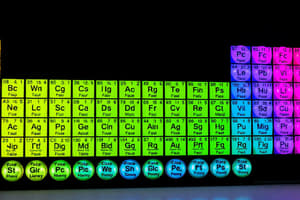Podcast
Questions and Answers
What are the positively charged particles found in the nucleus of an atom?
What are the positively charged particles found in the nucleus of an atom?
- Isotopes
- Protons (correct)
- Neutrons
- Electrons
Electrons are located in the nucleus of an atom.
Electrons are located in the nucleus of an atom.
False (B)
Define an element.
Define an element.
An element is a pure substance that cannot be broken down into other substances by physical or chemical means.
A pure substance formed when two or more different elements combine is called a ______.
A pure substance formed when two or more different elements combine is called a ______.
Match the following terms with their definitions:
Match the following terms with their definitions:
What is the arrangement of elements in the periodic table referred to as?
What is the arrangement of elements in the periodic table referred to as?
Compounds can be broken down into simpler substances by physical means.
Compounds can be broken down into simpler substances by physical means.
What are neutrons?
What are neutrons?
What does the upward curve in a chemical reaction diagram typically represent?
What does the upward curve in a chemical reaction diagram typically represent?
In an exothermic reaction, heat and/or light energy is released.
In an exothermic reaction, heat and/or light energy is released.
Why must chemical equations be balanced?
Why must chemical equations be balanced?
In a chemical reaction, ___ energy is required to initiate the breaking of bonds.
In a chemical reaction, ___ energy is required to initiate the breaking of bonds.
What is formed as a result of the reaction between glucose and oxygen?
What is formed as a result of the reaction between glucose and oxygen?
In a balanced chemical equation, the number of atoms of each element is the same on both the reactant and product sides.
In a balanced chemical equation, the number of atoms of each element is the same on both the reactant and product sides.
What type of chemical reaction absorbs heat energy?
What type of chemical reaction absorbs heat energy?
The process in which atoms or groups of atoms are reorganized into different substances is called a __________.
The process in which atoms or groups of atoms are reorganized into different substances is called a __________.
Match the following types of bonds to their descriptions:
Match the following types of bonds to their descriptions:
What does the arrow in a chemical equation indicate?
What does the arrow in a chemical equation indicate?
Exothermic reactions absorb heat from their surroundings.
Exothermic reactions absorb heat from their surroundings.
What is activation energy?
What is activation energy?
What is the role of a catalyst in a chemical reaction?
What is the role of a catalyst in a chemical reaction?
Enzymes are consumed in the chemical reactions they catalyze.
Enzymes are consumed in the chemical reactions they catalyze.
What is the specific location on an enzyme where substrates bind called?
What is the specific location on an enzyme where substrates bind called?
Enzymes can be affected by extreme changes in ______ and ______.
Enzymes can be affected by extreme changes in ______ and ______.
Which of the following describes the enzyme-substrate complex?
Which of the following describes the enzyme-substrate complex?
Which option describes how an enzyme increases the rate of a chemical reaction?
Which option describes how an enzyme increases the rate of a chemical reaction?
All enzymes function optimally at the same temperature and pH.
All enzymes function optimally at the same temperature and pH.
Flashcards
Atom
Atom
The smallest unit of matter that retains the properties of that element.
Element
Element
A pure substance that cannot be broken down into other substances by physical or chemical means.
Periodic Table
Periodic Table
A chart that organizes elements by their atomic number and properties.
Isotope
Isotope
Signup and view all the flashcards
Radioactive Isotope
Radioactive Isotope
Signup and view all the flashcards
Compound
Compound
Signup and view all the flashcards
Covalent bond
Covalent bond
Signup and view all the flashcards
Molecule
Molecule
Signup and view all the flashcards
Ionic bond
Ionic bond
Signup and view all the flashcards
Chemical reaction
Chemical reaction
Signup and view all the flashcards
Reactants
Reactants
Signup and view all the flashcards
Products
Products
Signup and view all the flashcards
Chemical Equation
Chemical Equation
Signup and view all the flashcards
Balanced chemical equation
Balanced chemical equation
Signup and view all the flashcards
Activation energy
Activation energy
Signup and view all the flashcards
Exothermic reaction
Exothermic reaction
Signup and view all the flashcards
Enzyme
Enzyme
Signup and view all the flashcards
Reactants and Products in Chemical Reactions
Reactants and Products in Chemical Reactions
Signup and view all the flashcards
Balancing Chemical Equations
Balancing Chemical Equations
Signup and view all the flashcards
Catalyst
Catalyst
Signup and view all the flashcards
Substrates
Substrates
Signup and view all the flashcards
Active Site
Active Site
Signup and view all the flashcards
Enzyme-substrate Complex
Enzyme-substrate Complex
Signup and view all the flashcards
Factors Affecting Enzyme Activity
Factors Affecting Enzyme Activity
Signup and view all the flashcards
Denaturation
Denaturation
Signup and view all the flashcards
Study Notes
Chemistry in Biology: Atoms, Elements, and Compounds
- Chemistry is the study of matter.
- Atoms are the fundamental building blocks of matter.
- Neutrons and protons are located in the atom's nucleus.
- Protons have a positive charge.
- Neutrons have no charge.
- Electrons have a negative charge and orbit the nucleus.
- Elements are pure substances that cannot be broken down into simpler substances by physical or chemical means.
- There are over 100 known elements, with 92 occurring naturally.
- Each element has a unique name and symbol.
- The periodic table organizes elements by increasing atomic number.
- Horizontal rows are called periods.
- Vertical columns are called groups or families.
- Isotopes are atoms of the same element with the same number of protons and electrons but a different number of neutrons.
- Radioactive isotopes give off radiation when their nuclei break apart, used in various applications.
- Compounds are pure substances formed when two or more different elements combine in a fixed ratio.
- Compounds cannot be broken down into simpler substances by physical means.
- Chemical bonds hold atoms together in compounds.
- Covalent bonds form when atoms share electrons.
- A molecule is a compound whose atoms are held together by covalent bonds.
- Ionic bonds form through electrical attraction between oppositely charged atoms or groups of atoms.
Chemical Reactions
- A chemical reaction is the process where atoms or groups of atoms in substances are rearranged to form new substances.
- Clues indicating a chemical reaction include heat/light production, gas/liquid/solid formation.
- Chemical formulas depict substances in reactions. Arrows indicate the change process.
- Reactants are starting substances (left side of the reaction arrow).
- Products are substances produced during the reaction (right side of the reaction arrow).
- The law of conservation of mass states matter cannot be created or destroyed during a chemical reaction. Therefore, in a balanced equation, the number of atoms of each element must be equal on both sides of the equation.
- Glucose and oxygen react to form carbon dioxide and water (C₆H₁₂O₆ + 6O₂ → 6CO₂ + 6H₂O).
- Activation energy is the minimum energy required for a reaction to start, crucial for chemical reactions.
- Exothermic reactions release energy (heat). Energy is lower in final products comparing to reactants.
- Endothermic reactions absorb energy (heat). Energy is higher in final products comparing to reactants.
- Catalysts, like enzymes, lower the activation energy needed to start chemical reactions.
- Enzymes are biological catalysts, crucial for life processes.
- Substrates are reactants that bind to enzymes.
- Active sites are specific locations on enzymes where substrates attach.
- Enzymes change shape during reactions to facilitate bonds breaking, forming new ones.
- Factors like pH and temperature affect enzyme activity and can denature enzymes, which means their shape changes and they lose function.
Chapter Diagnostic & Formative Questions
- Enzymes are proteins that speed up chemical reactions by lowering activation energy.
- A match burning is an example of a chemical reaction.
- Reactions that absorb energy are endothermic.
- Enzymes lower the activation energy needed for reactions to occur.
- In an enzyme-substrate complex, chemical bonds are broken and new bonds are formed which will form products.
- Activation energy is the upward curve on a reaction energy diagram.
- Chemical reactions must be balanced because mass is conserved in chemical reactions.
Studying That Suits You
Use AI to generate personalized quizzes and flashcards to suit your learning preferences.




